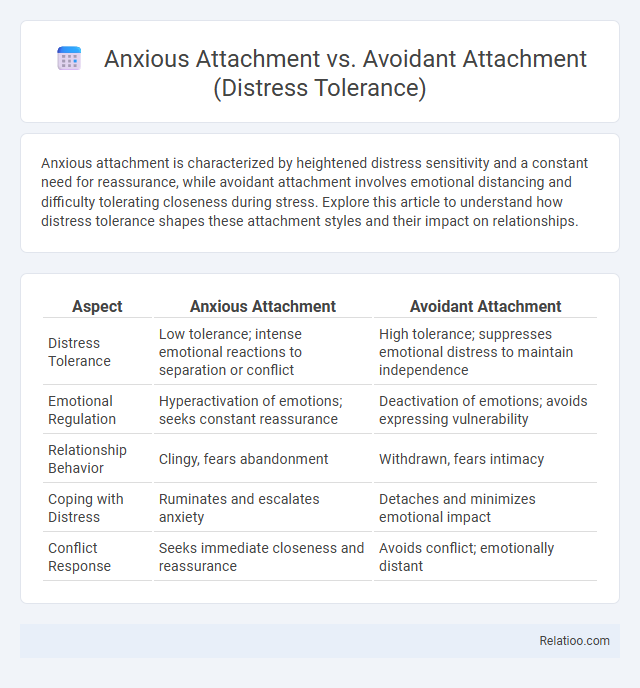Anxious attachment is characterized by heightened distress sensitivity and a constant need for reassurance, while avoidant attachment involves emotional distancing and difficulty tolerating closeness during stress. Explore this article to understand how distress tolerance shapes these attachment styles and their impact on relationships.
Table of Comparison
| Aspect | Anxious Attachment | Avoidant Attachment |
|---|---|---|
| Distress Tolerance | Low tolerance; intense emotional reactions to separation or conflict | High tolerance; suppresses emotional distress to maintain independence |
| Emotional Regulation | Hyperactivation of emotions; seeks constant reassurance | Deactivation of emotions; avoids expressing vulnerability |
| Relationship Behavior | Clingy, fears abandonment | Withdrawn, fears intimacy |
| Coping with Distress | Ruminates and escalates anxiety | Detaches and minimizes emotional impact |
| Conflict Response | Seeks immediate closeness and reassurance | Avoids conflict; emotionally distant |
Introduction to Attachment Styles
Anxious attachment is characterized by heightened sensitivity to rejection and a strong desire for closeness, often leading to emotional distress when needs aren't immediately met. Avoidant attachment involves discomfort with intimacy and a tendency to distance oneself emotionally, which can impact your ability to tolerate distress effectively. Understanding these distinct attachment styles helps in recognizing how your distress tolerance differs, shaping your emotional responses and coping strategies in relationships.
Defining Anxious Attachment
Anxious attachment is characterized by a heightened sensitivity to rejection and a persistent craving for reassurance in relationships, often leading to emotional dependency and fear of abandonment. This attachment style contrasts with avoidant attachment, where distress tolerance is marked by emotional distancing and suppression of needs to manage discomfort. Your ability to recognize these patterns enhances distress tolerance by fostering healthier emotional regulation and interpersonal dynamics.
Understanding Avoidant Attachment
Avoidant attachment is characterized by discomfort with closeness and a tendency to suppress emotional needs, which directly impacts your distress tolerance by promoting emotional distancing rather than engagement. Unlike anxious attachment, where individuals seek reassurance and experience heightened emotional reactivity, avoidant individuals manage distress through detachment and self-reliance, often minimizing their emotional experiences. Understanding avoidant attachment helps in recognizing how emotional suppression affects stress responses and highlights the importance of gradually increasing emotional awareness to improve distress tolerance skills.
Overview of Distress Tolerance
Distress tolerance refers to an individual's capacity to withstand emotional pain or discomfort without resorting to maladaptive behaviors. In the context of attachment styles, those with anxious attachment often exhibit low distress tolerance, leading to heightened emotional reactivity and difficulty managing anxiety in relationships. Conversely, individuals with avoidant attachment may appear to have higher distress tolerance by suppressing emotions, but this often results in emotional disengagement rather than genuine regulation of distress.
How Anxious Attachment Influences Distress Tolerance
Anxious attachment significantly lowers distress tolerance by heightening emotional sensitivity and fear of abandonment, causing individuals to experience intense distress during conflicts or uncertainty. This attachment style often leads to hypervigilance and difficulty calming down, impairing effective coping mechanisms under stress. In contrast, avoidant attachment is characterized by emotional suppression and detachment, resulting in different distress tolerance challenges that prioritize emotional avoidance over heightened emotional reactivity.
Distress Tolerance in Avoidant Attachment
Distress tolerance in avoidant attachment is characterized by a strong preference to suppress emotions and maintain self-reliance during stressful situations, often leading to emotional distancing from others. Individuals with avoidant attachment exhibit higher distress tolerance by minimizing vulnerability and avoiding reliance on social support, contrasting with anxious attachment where distress triggers heightened emotional sensitivity and a need for reassurance. Understanding your distress tolerance in avoidant attachment helps you develop healthier coping strategies, fostering better emotional regulation and interpersonal connections.
Key Differences: Anxious vs Avoidant Distress Responses
Anxious attachment triggers intense emotional distress and a heightened need for reassurance during conflicts, whereas avoidant attachment manifests as emotional withdrawal and suppression of distress to maintain independence. Your distress tolerance varies significantly, with anxious individuals often struggling to regulate overwhelming emotions, while avoidant individuals detach to minimize emotional discomfort. These key differences influence how each attachment style manages stress and seeks comfort in relationships.
Impact on Relationships and Emotional Regulation
Anxious attachment often leads to heightened emotional intensity and fears of abandonment, causing inconsistent communication and dependence that strain relationships. Avoidant attachment typically results in emotional distancing and suppression, impairing intimacy and reducing conflict resolution effectiveness. Distress tolerance skills enhance emotional regulation by enabling individuals to manage intense feelings without impulsive reactions, improving relationship stability and communication.
Strategies to Improve Distress Tolerance for Each Style
Individuals with anxious attachment often struggle with distress tolerance due to heightened emotional sensitivity, making grounding techniques like deep breathing and mindfulness essential to manage overwhelming feelings. Those with avoidant attachment benefit from strategies emphasizing emotional regulation through self-soothing practices and gradual exposure to vulnerability to reduce emotional withdrawal. Enhancing distress tolerance across these attachment styles involves personalized coping mechanisms that promote awareness, self-compassion, and adaptive responses to emotional discomfort.
Conclusion: Building Secure Attachment and Resilience
Developing secure attachment involves cultivating consistent emotional availability and effective communication to replace anxious or avoidant patterns. Enhancing distress tolerance skills strengthens resilience by promoting healthy regulation of emotional responses and reducing dependency on maladaptive coping mechanisms. Integrating these approaches supports long-term psychological well-being and stable interpersonal relationships.

Infographic: Anxious Attachment vs Avoidant Attachment (Distress Tolerance)
 relatioo.com
relatioo.com